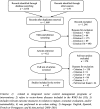Impact, economic evaluation, and sustainability of integrated vector management in urban settings to prevent vector-borne diseases: a scoping review
- PMID: 30173675
- PMCID: PMC6120095
- DOI: 10.1186/s40249-018-0464-x
Impact, economic evaluation, and sustainability of integrated vector management in urban settings to prevent vector-borne diseases: a scoping review
Abstract
Background: The control of vector-borne diseases (VBD) is one of the greatest challenges on the global health agenda. Rapid and uncontrolled urbanization has heightened the interest in addressing these challenges through an integrated vector management (IVM) approach. The aim was to identify components related to impacts, economic evaluation, and sustainability that might contribute to this integrated approach to VBD prevention.
Main body: We conducted a scoping review of available literature (2000-2016) using PubMed, Web of Science, Cochrane, CINAHL, Econlit, LILACS, Global Health Database, Scopus, and Embase, as well as Tropical Diseases Bulletin, WHOLIS, WHO Pesticide Evaluation Scheme, and Google Scholar. MeSH terms and free-text terms were used. A data extraction form was used, including TIDieR and ASTAIRE. MMAT and CHEERS were used to evaluate quality. Of the 42 documents reviewed, 30 were focused on dengue, eight on malaria, and two on leishmaniasis. More than a half of the studies were conducted in the Americas. Half used a quantitative descriptive approach (n = 21), followed by cluster randomized controlled trials (n = 11). Regarding impacts, outcomes were: a) use of measures for vector control; b) vector control; c) health measures; and d) social measures. IVM reduced breeding sites, the entomology index, and parasite rates. Results were heterogeneous, with variable magnitudes, but in all cases were favourable to the intervention. Evidence of IVM impacts on health outcomes was very limited but showed reduced incidence. Social outcomes were improved abilities and capacities, empowerment, and community knowledge. Regarding economic evaluation, only four studies performed an economic analysis, and intervention benefits outweighed costs. Cost-effectiveness was dependent on illness incidence. The results provided key elements to analyze sustainability in terms of three dimensions (social, economic, and environmental), emphasizing the implementation of a community-focused eco-bio-social approach.
Conclusions: IVM has an impact on reducing vector breeding sites and the entomology index, but evidence of impacts on health outcomes is limited. Social outcomes are improved abilities and capacities, empowerment, and community knowledge. Economic evaluations are scarce, and cost-effectiveness is dependent on illness incidence. Community capacity building is the main component of sustainability, together with collaboration, institutionalization, and routinization of activities. Findings indicate a great heterogeneity in the interventions and highlight the need for characterizing interventions rigorously to facilitate transferability.
Keywords: Integrated vector management; Intervention; Scoping review; Urban health; Vector-borne diseases.
Conflict of interest statement
Ethics approval and consent to participate
The study protocol was approved by the Human Research Ethics Committee, University of Montreal.
Consent for publication
Not applicable
Competing interests
The authors declare that they have no competing interests.
Figures
Similar articles
-
A scoping review on the field validation and implementation of rapid diagnostic tests for vector-borne and other infectious diseases of poverty in urban areas.Infect Dis Poverty. 2018 Sep 3;7(1):87. doi: 10.1186/s40249-018-0474-8. Infect Dis Poverty. 2018. PMID: 30173662 Free PMC article.
-
Consolidating tactical planning and implementation frameworks for integrated vector management in Uganda.Malar J. 2016 Apr 14;15:214. doi: 10.1186/s12936-016-1269-7. Malar J. 2016. PMID: 27074809 Free PMC article.
-
Application of eco-friendly tools and eco-bio-social strategies to control dengue vectors in urban and peri-urban settings in Thailand.Pathog Glob Health. 2012 Dec;106(8):446-54. doi: 10.1179/2047773212Y.0000000059. Pathog Glob Health. 2012. PMID: 23318236 Free PMC article. Clinical Trial.
-
Scoping review on vector-borne diseases in urban areas: transmission dynamics, vectorial capacity and co-infection.Infect Dis Poverty. 2018 Sep 3;7(1):90. doi: 10.1186/s40249-018-0475-7. Infect Dis Poverty. 2018. PMID: 30173661 Free PMC article.
-
Effective surveillance systems for vector-borne diseases in urban settings and translation of the data into action: a scoping review.Infect Dis Poverty. 2018 Sep 3;7(1):99. doi: 10.1186/s40249-018-0473-9. Infect Dis Poverty. 2018. PMID: 30217142 Free PMC article.
Cited by
-
Optimization of convolutional neural network hyperparameters for automatic classification of adult mosquitoes.PLoS One. 2020 Jul 14;15(7):e0234959. doi: 10.1371/journal.pone.0234959. eCollection 2020. PLoS One. 2020. PMID: 32663230 Free PMC article.
-
Effectiveness of Aedes-borne infectious disease control in Latin America and the Caribbean region: A scoping review.PLoS One. 2022 Nov 2;17(11):e0277038. doi: 10.1371/journal.pone.0277038. eCollection 2022. PLoS One. 2022. PMID: 36322603 Free PMC article.
-
Cutaneous leishmaniasis control in Alta Verapaz (northern Guatemala): evaluating current efforts through stakeholders' experiences.Infect Dis Poverty. 2021 May 7;10(1):61. doi: 10.1186/s40249-021-00842-3. Infect Dis Poverty. 2021. PMID: 33962699 Free PMC article.
-
Effects of the Developing and Using a Model to Predict Dengue Risk Villages Based on Subdistrict Administrative Organization in Southern Thailand.Int J Environ Res Public Health. 2022 Sep 22;19(19):11989. doi: 10.3390/ijerph191911989. Int J Environ Res Public Health. 2022. PMID: 36231289 Free PMC article.
-
Selected Research Issues of Urban Public Health.Int J Environ Res Public Health. 2022 May 3;19(9):5553. doi: 10.3390/ijerph19095553. Int J Environ Res Public Health. 2022. PMID: 35564947 Free PMC article. Review.
References
-
- WHO . A global brief on vector-borne diseases. 2014.
-
- WHO . Global strategic framework for integrated vector management. Geneva: World Health Organization; 2004.
Publication types
MeSH terms
LinkOut - more resources
Full Text Sources
Other Literature Sources
Medical




